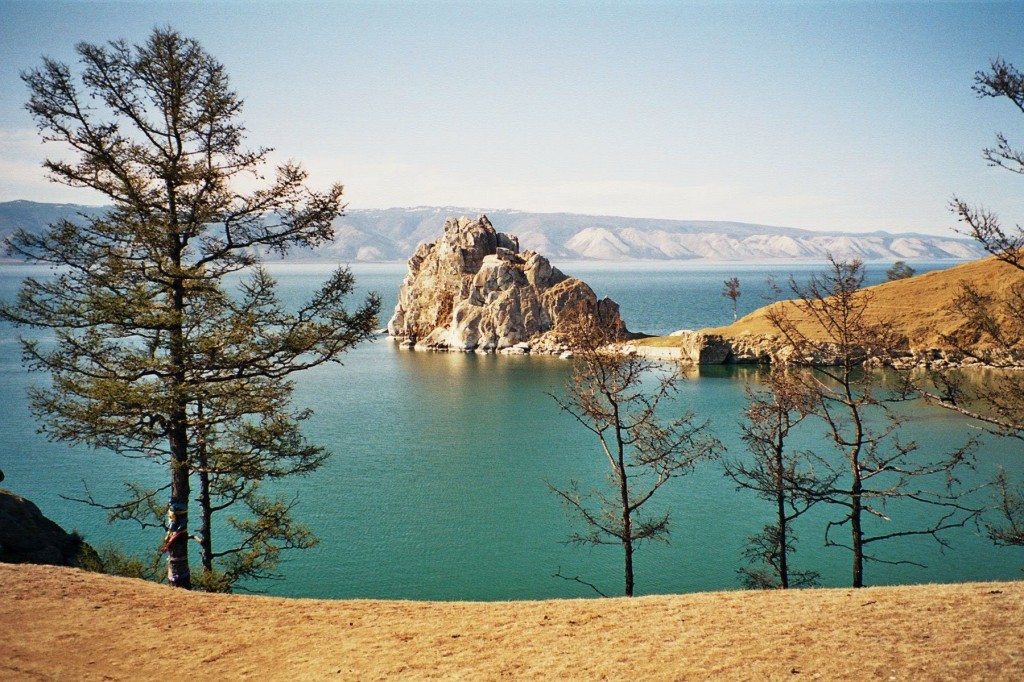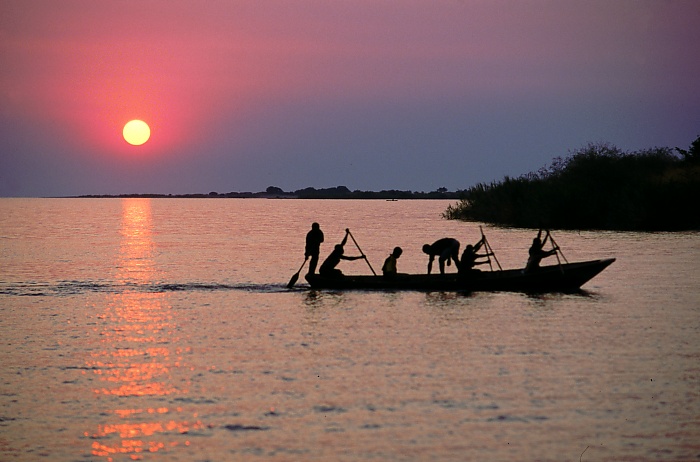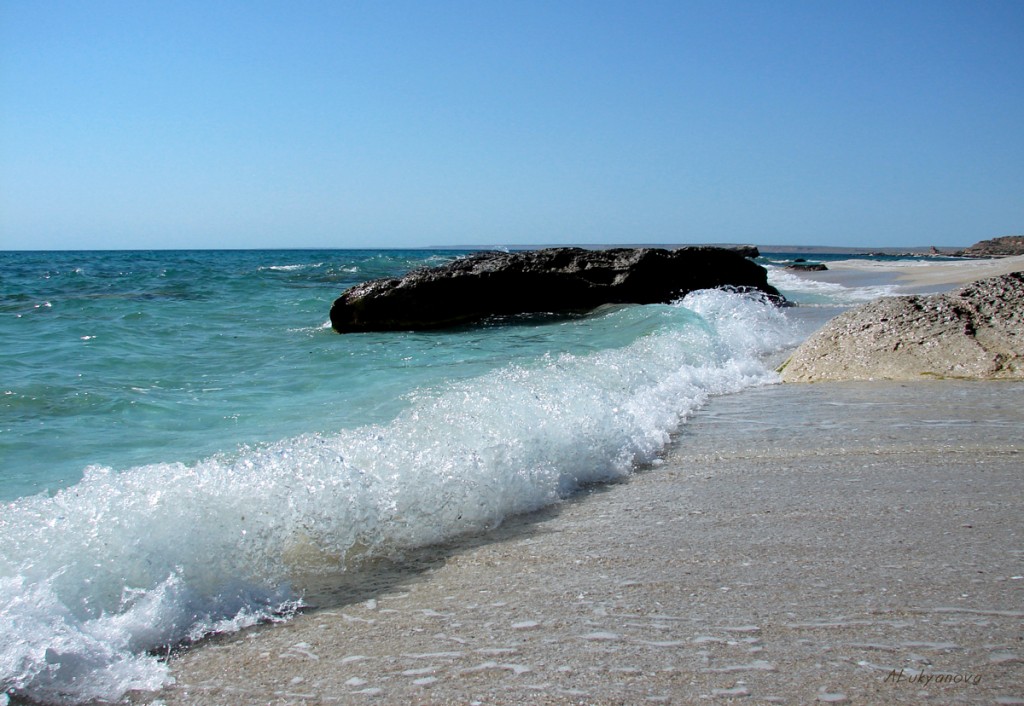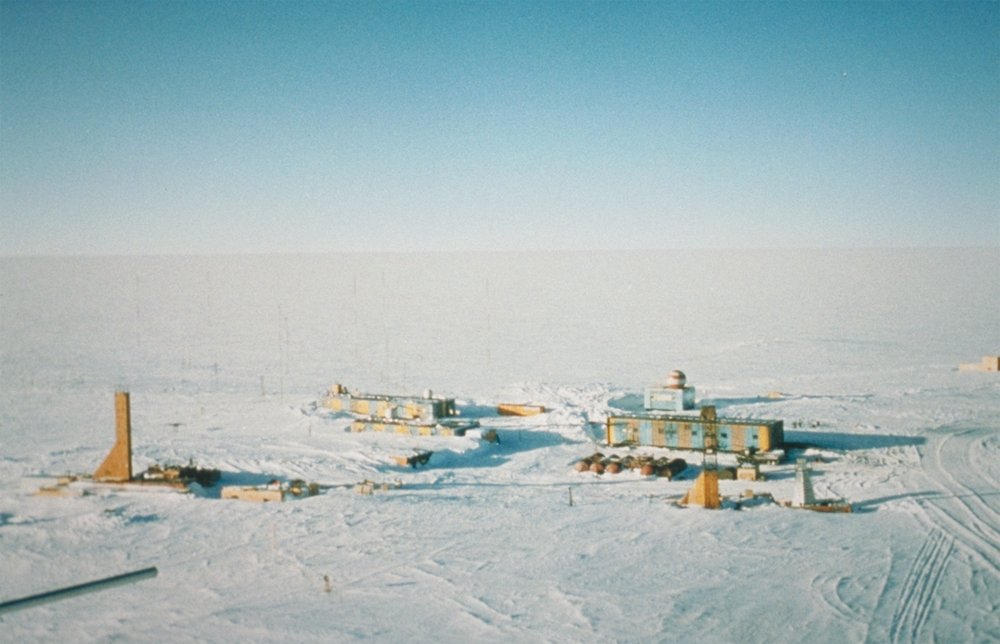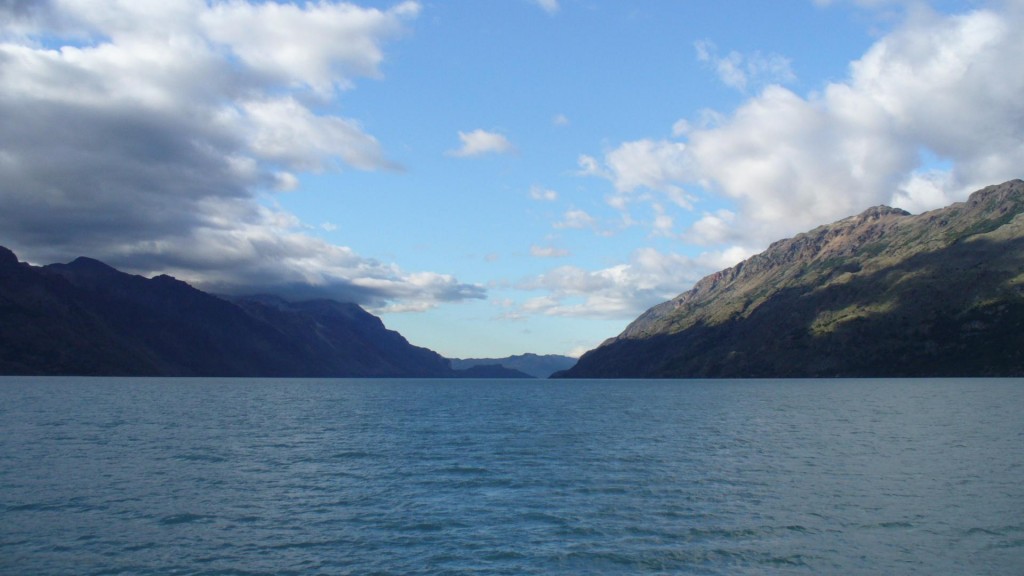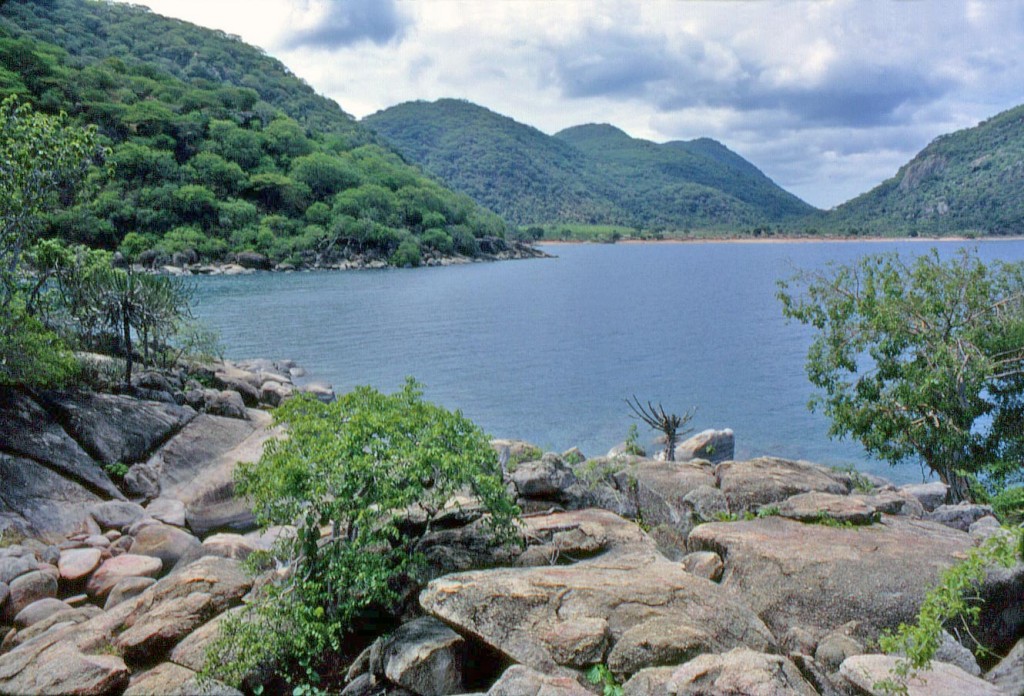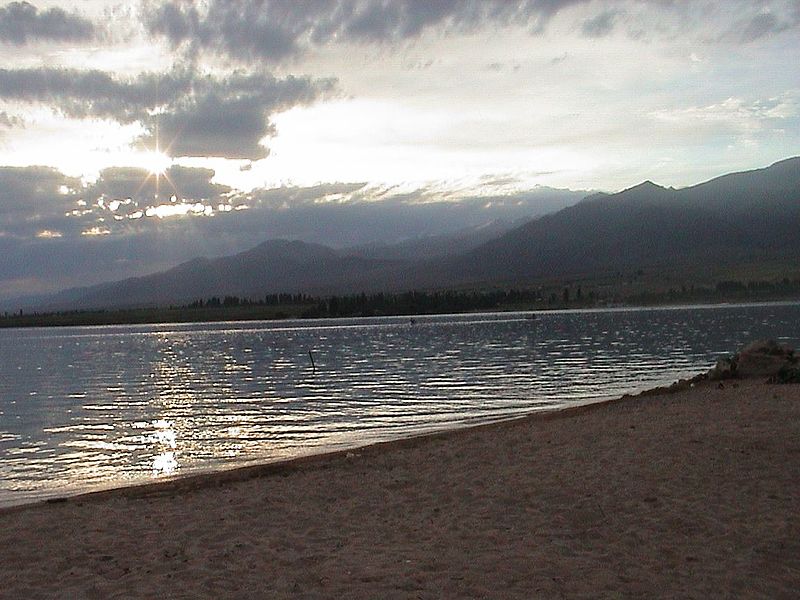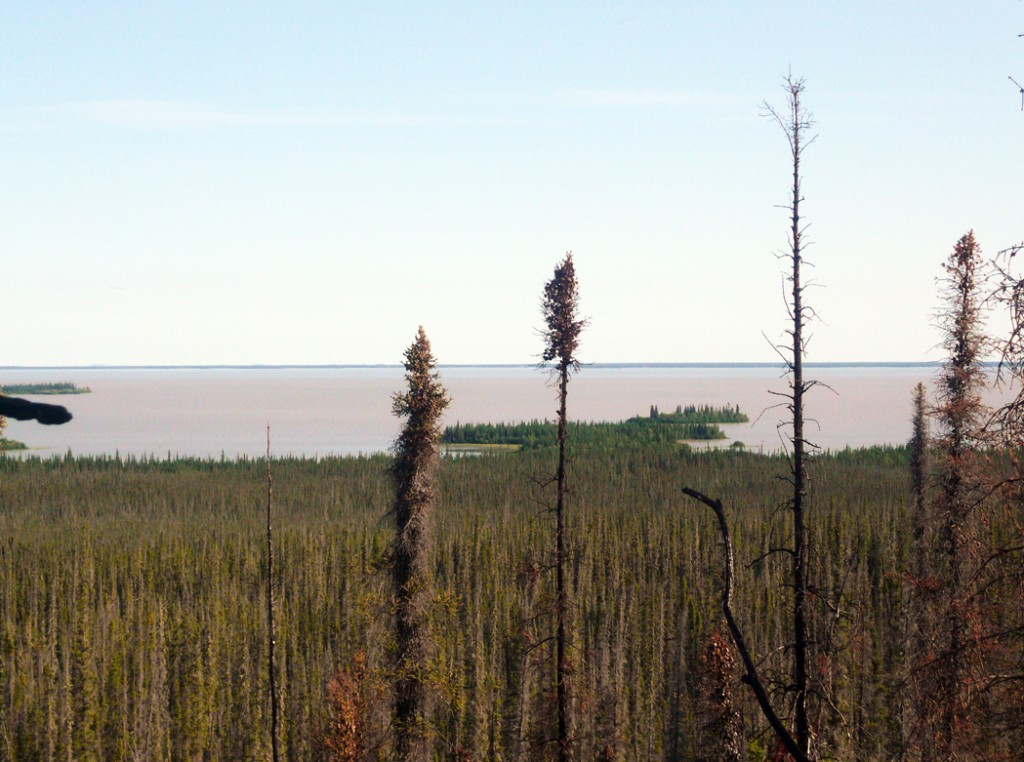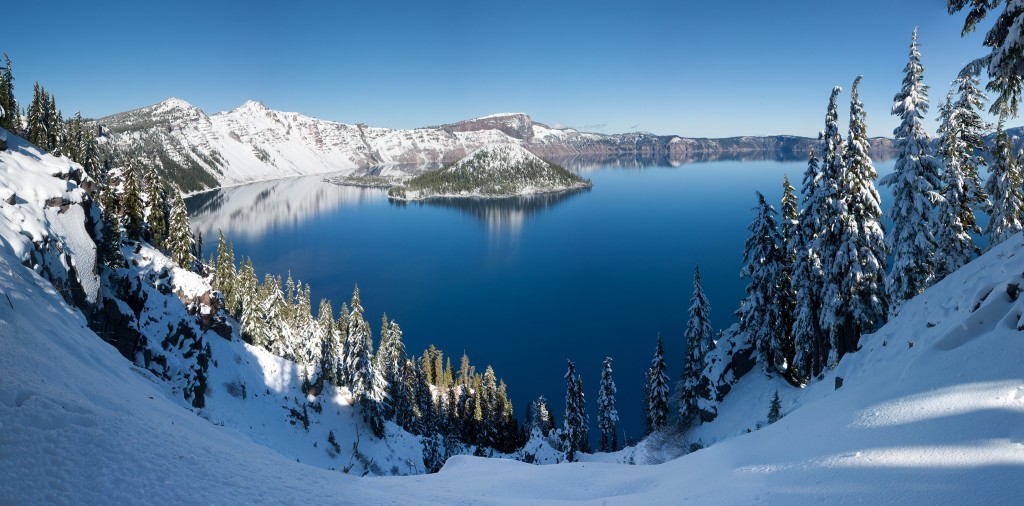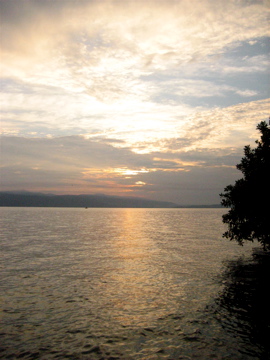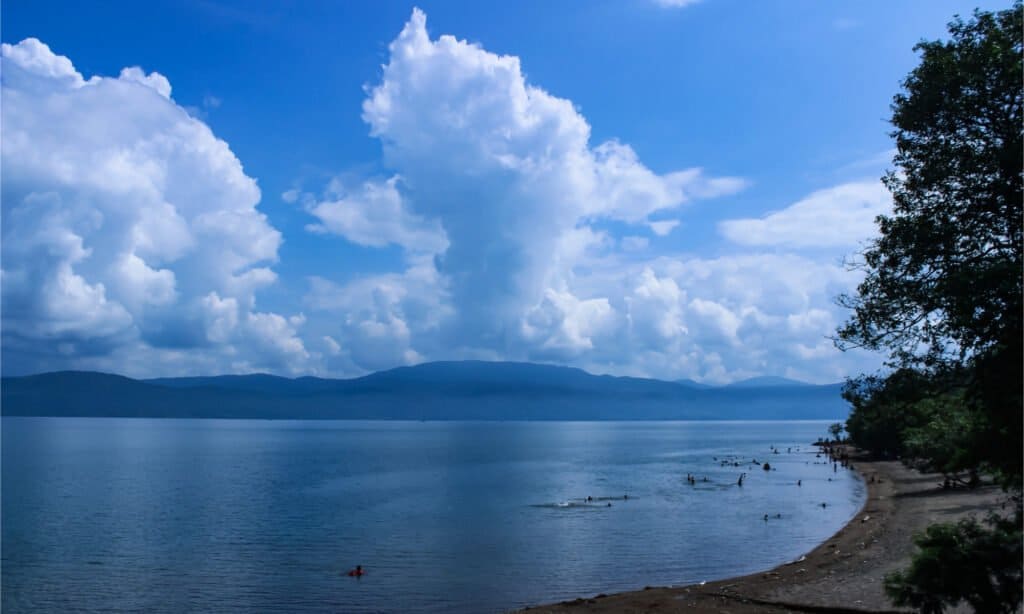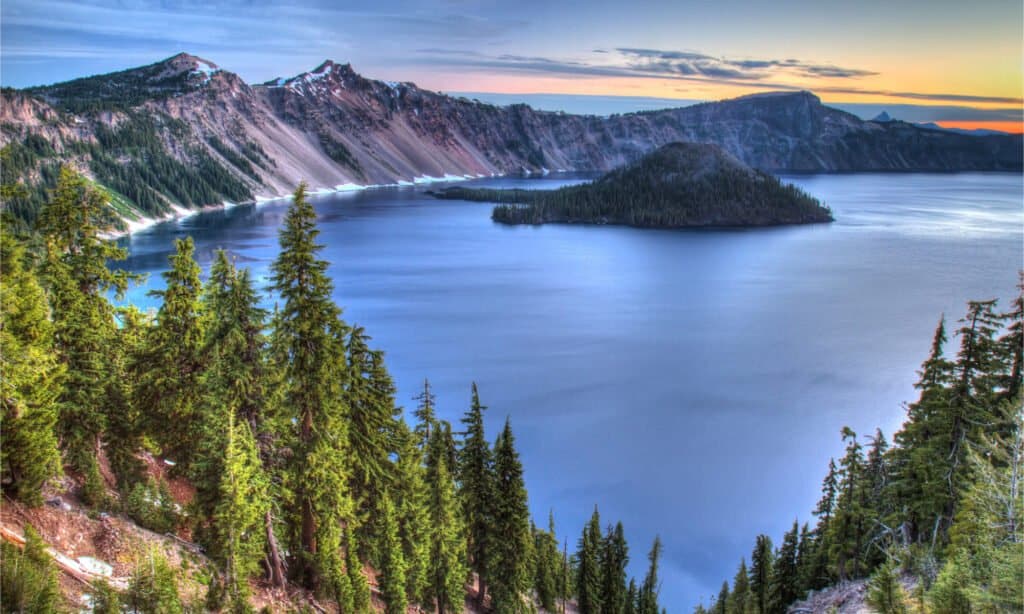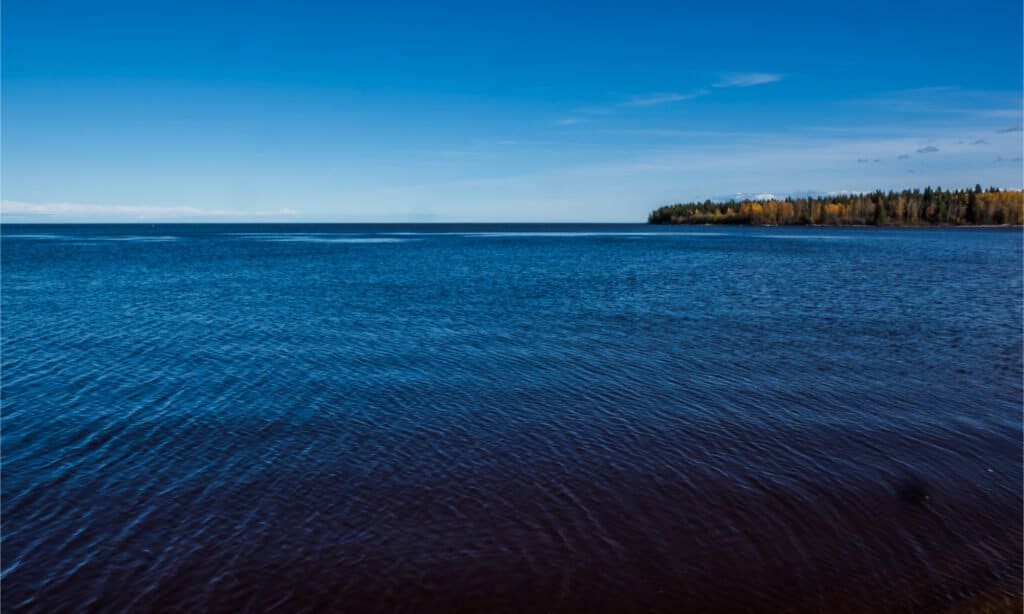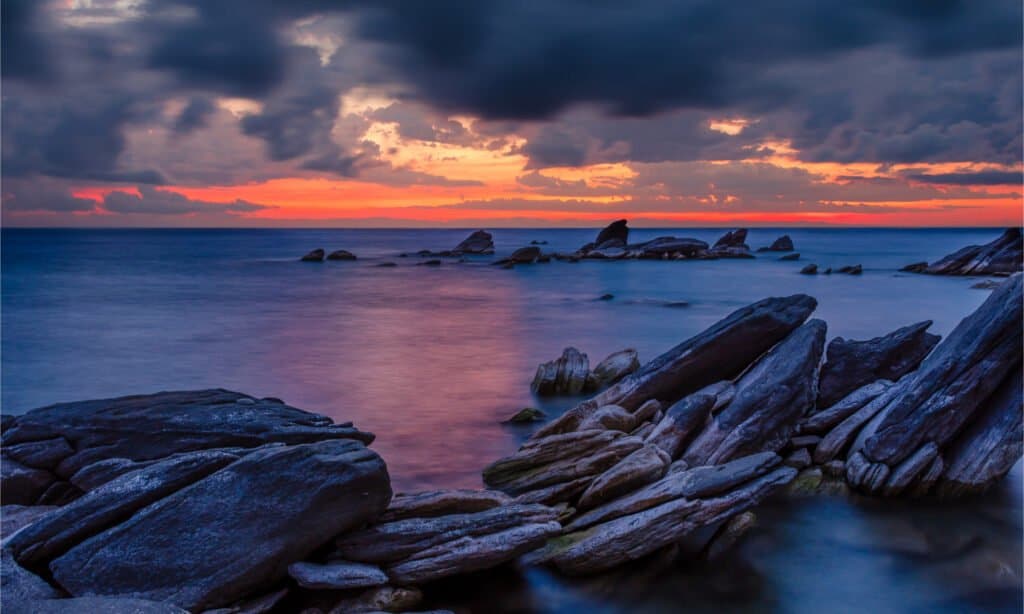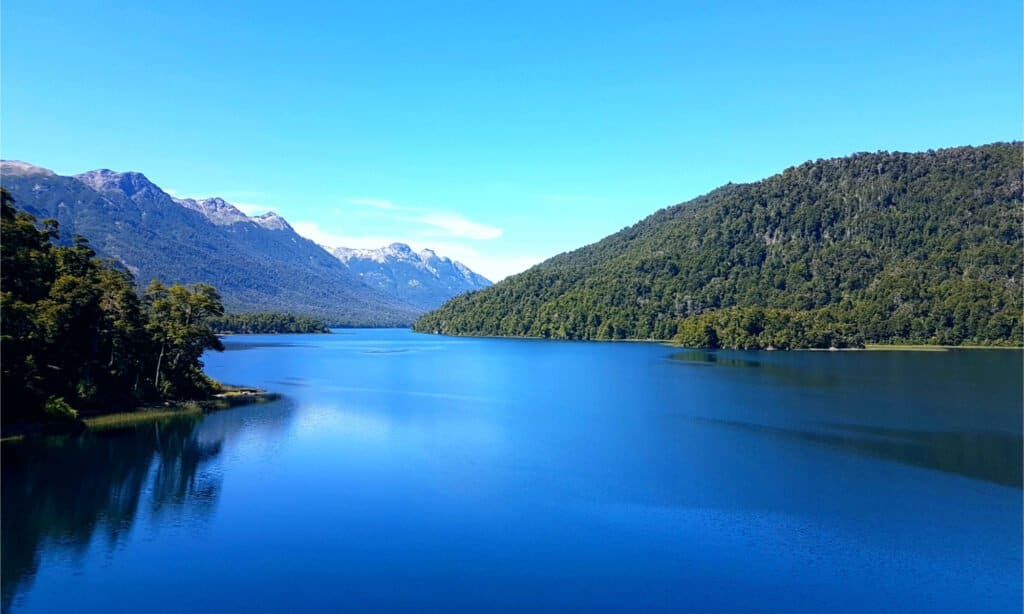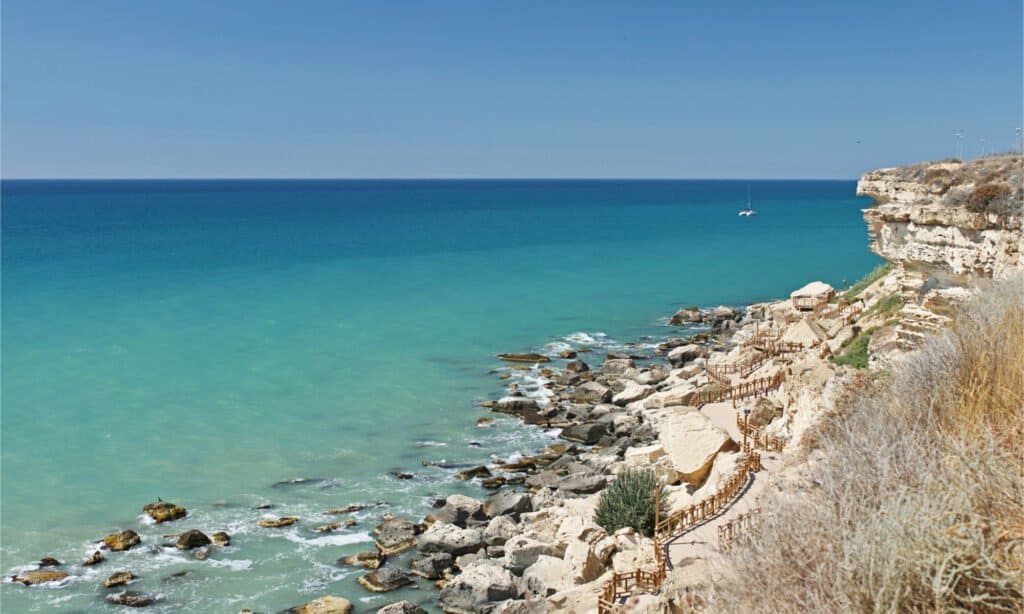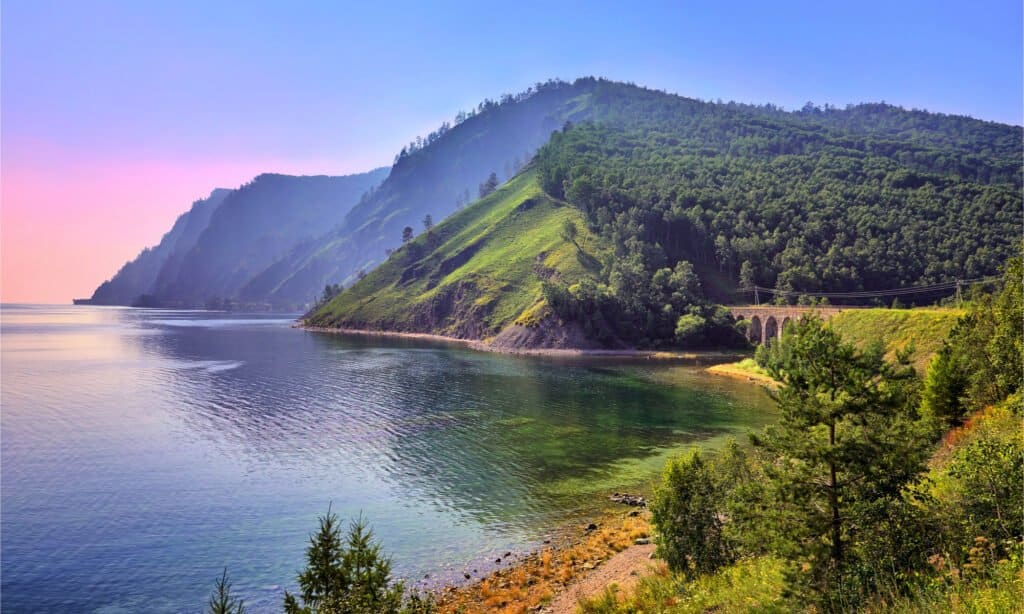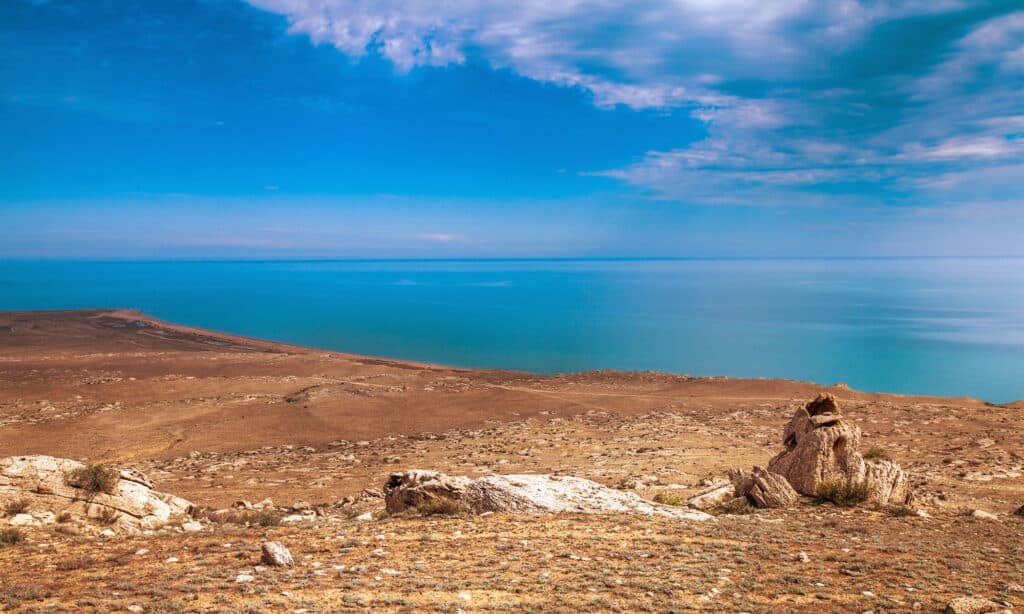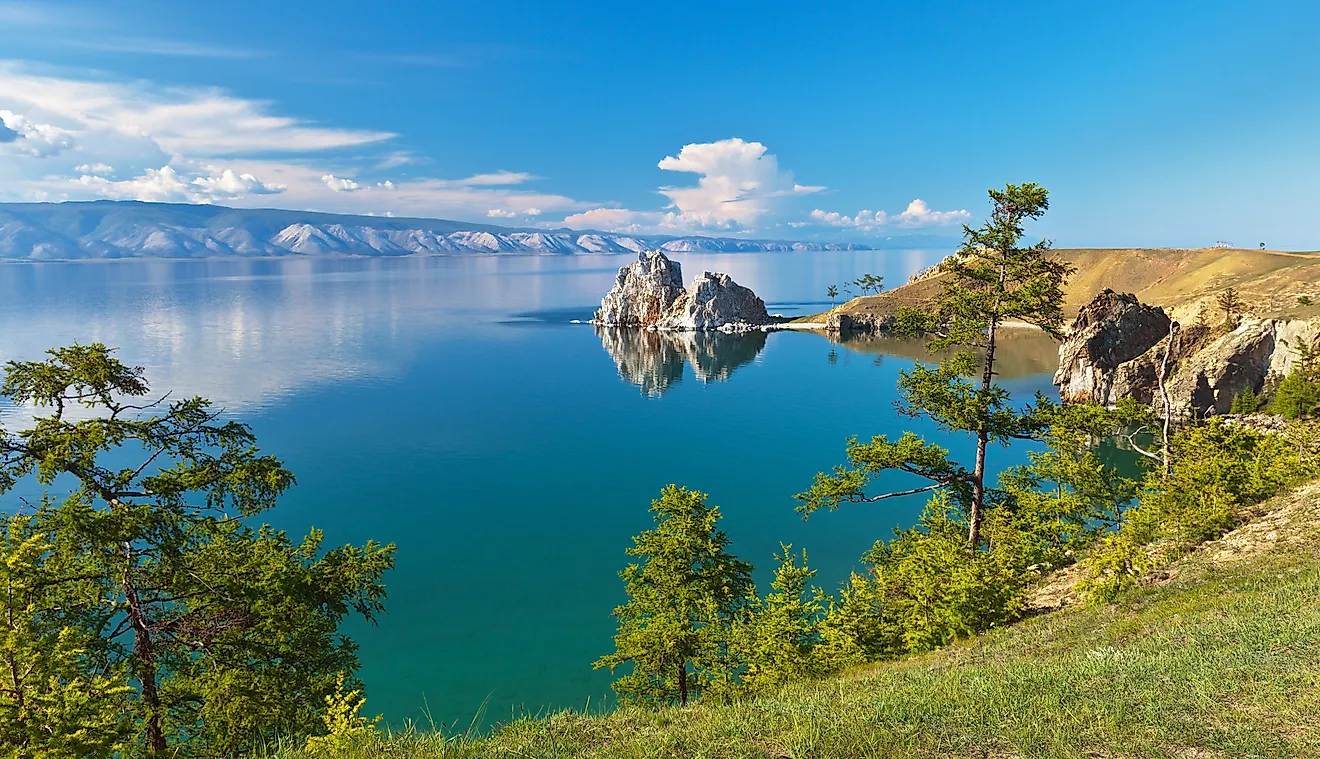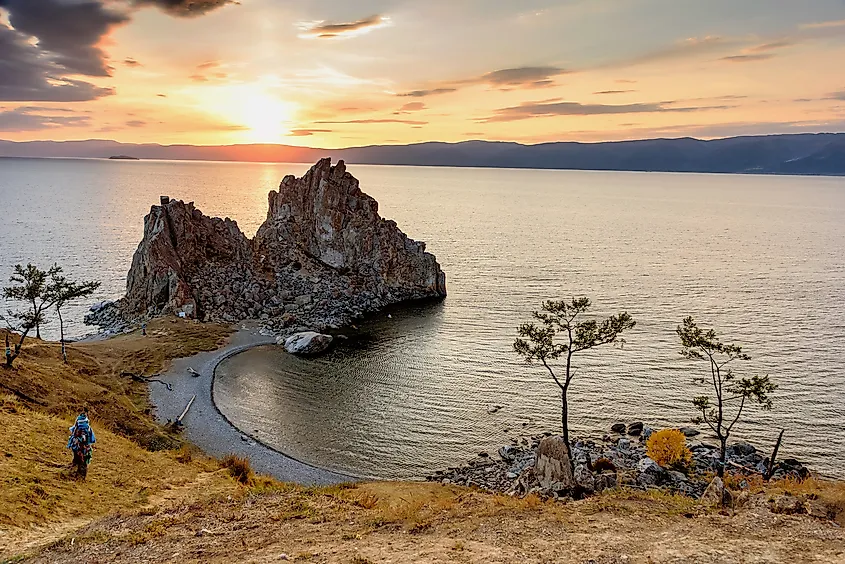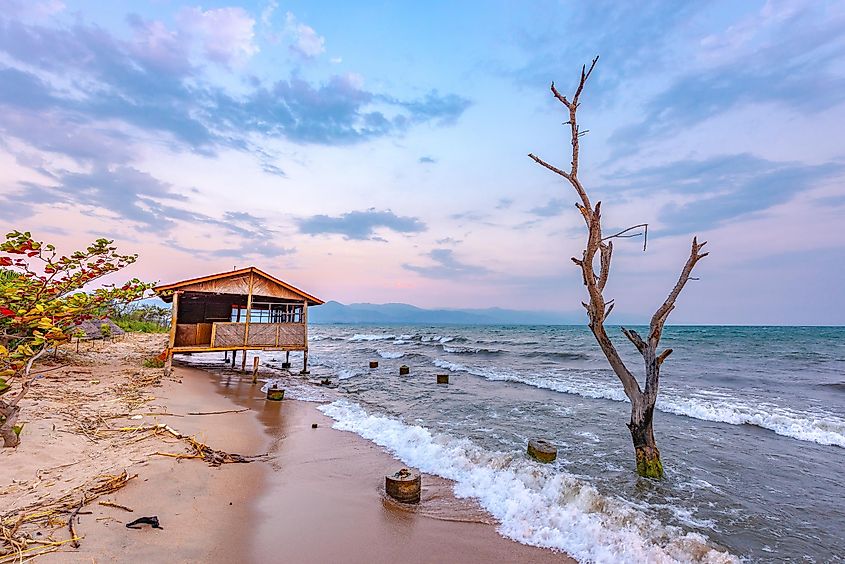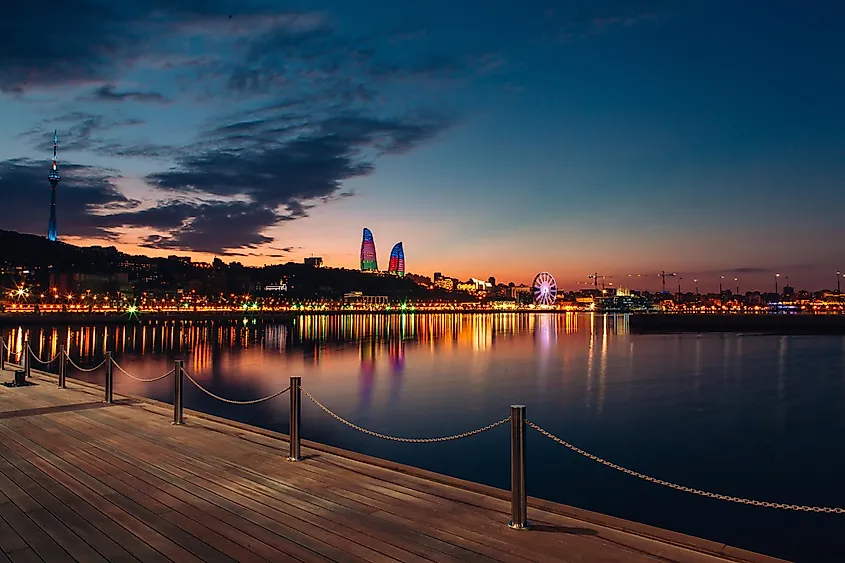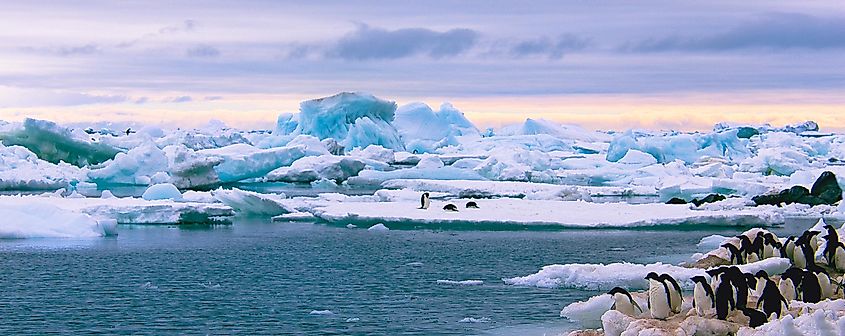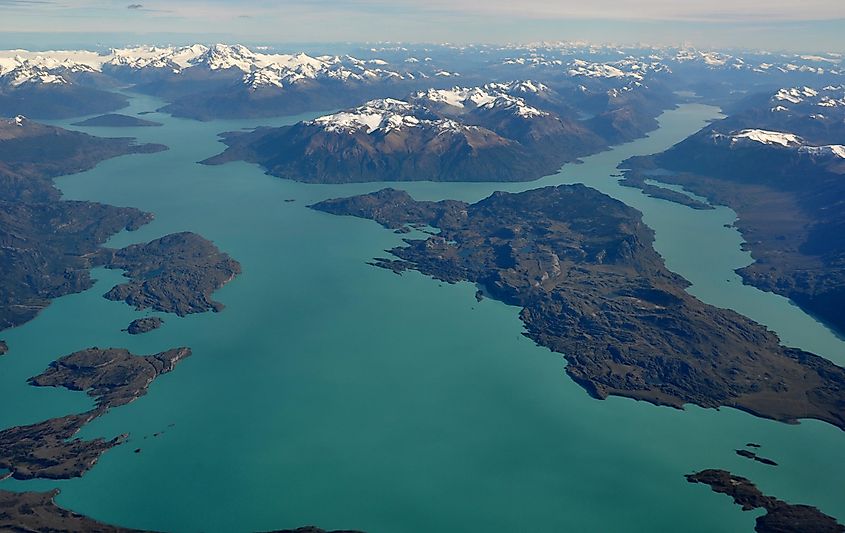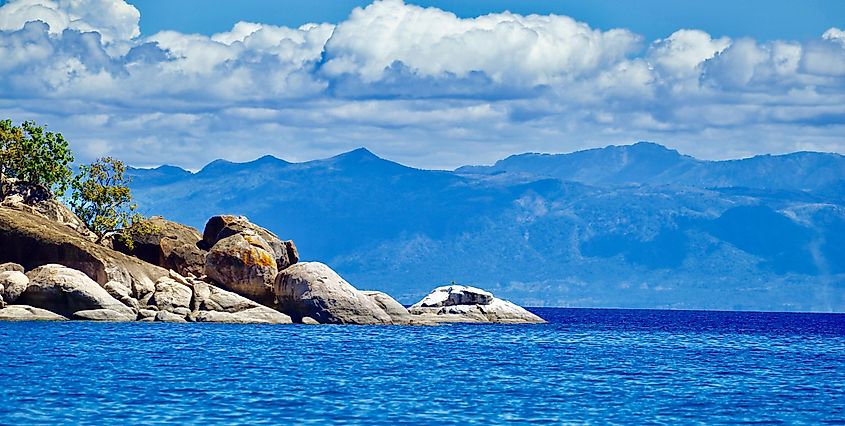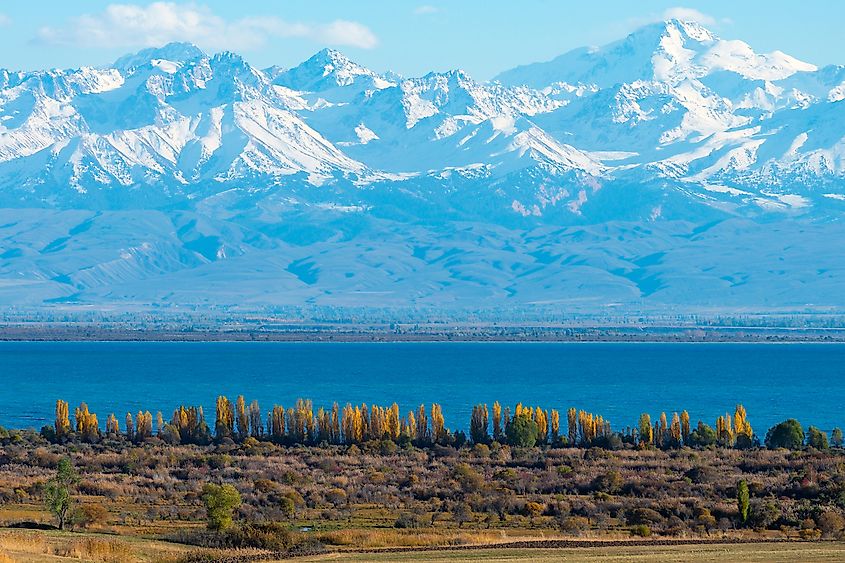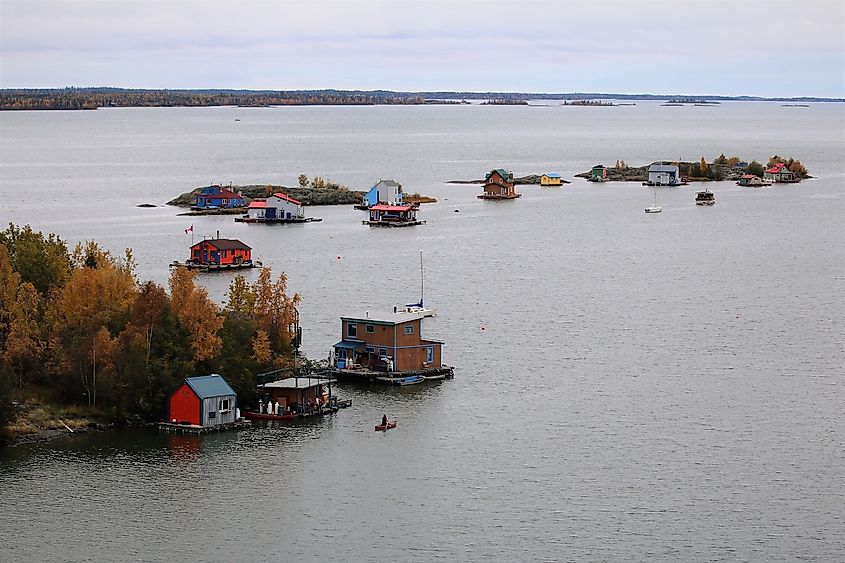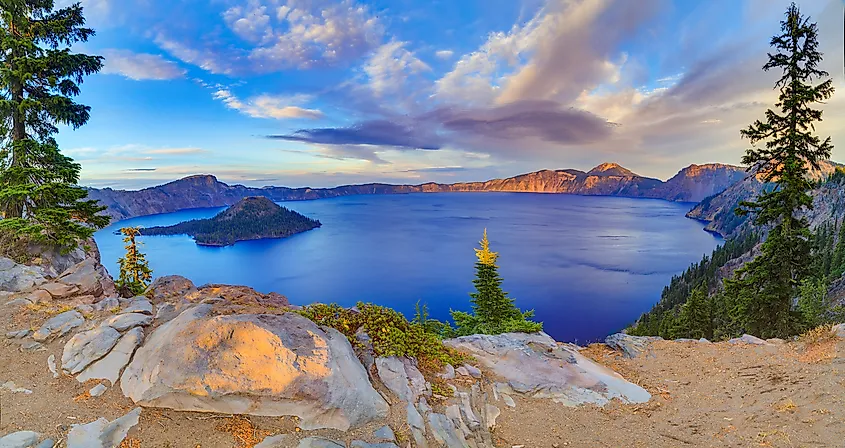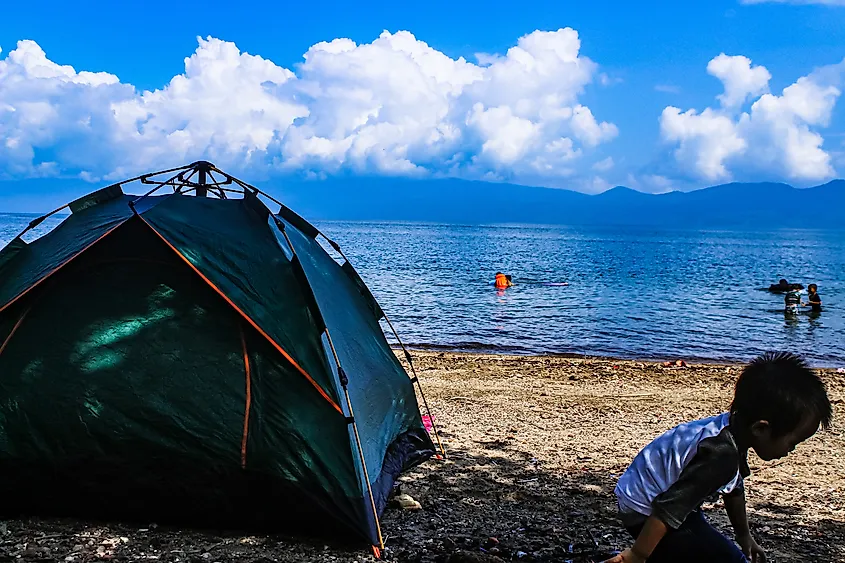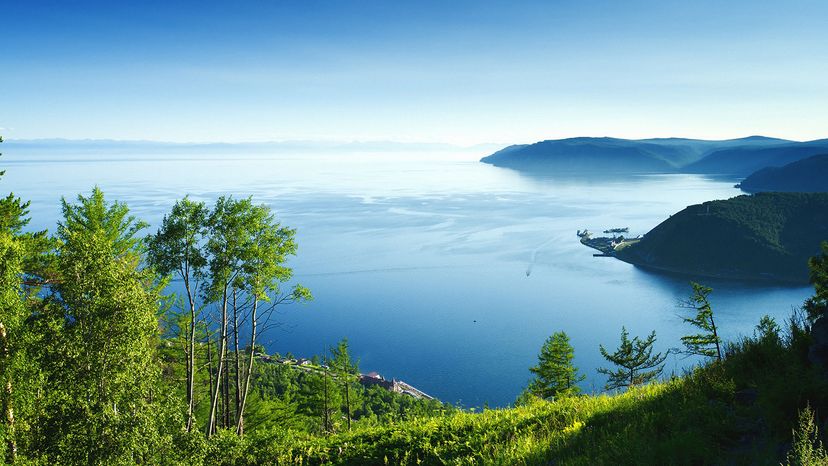This is a list of the world’s deepest lakes (you can also take a look at the world’s largest lakes by area):
1. Lake Baikal, Siberia, Russia
Deepest lake in the world with a depth of 1,637 meters (5369 ft). Lake Baikal is also the most voluminous freshwater lake in the world, containing roughly 20% of the world’s unfrozen surface fresh water.
10 Deepest Lakes In The World: Lake Baikal, Siberia, Russia
2. Lake Tanganyika, Central Africa
1,470 meters deep (4,823 ft). It is estimated to be also the second largest freshwater lake in the world by volume. The lake is divided among four countries – Tanzania, the Democratic Republic of the Congo, Burundi, and Zambia.
10 Deepest Lakes In The World: Lake Tanganyika, central Africa
3. The Caspian Sea
1,025 meters (3,363 ft). It is the largest enclosed inland body of water on Earth by area, variously classed as the world’s largest lake or a full-fledged sea.it has no outflows and is bounded by Russia, Azerbaijan, Iran, Turkmenistan and Kazakhstan.
10 Deepest Lakes In The World: The Caspian sea
4. Lake Vostok, Antartica
900 meters (3000 ft). Lake is the largest of Antarctica’s almost 400 known subglacial lakes. The lake is located beneath Russia’s Vostok Station under the surface of the central East Antarctic Ice Sheet.
10 Deepest Lakes In The World: Lake Vostok, Antartica
5. Lake O’Higgins-San Martín, Chile & Argentina
836 meters (2,742 ft) deep. Located in Patagonia, It has a surface area of 1,013 km and a shoreline length of 525 km. Viewed from above, the lake consists of a series of finger-shaped flooded valleys, of which 554 km are in Chile and 459 km in Argentina.
10 Deepest Lakes In The World: Lake O’Higgins-San Martín
6. Lake Malawi, Mozambique, Tanzania, Malawi
706 meters (2,316 ft). The third largest and second deepest lake in Africa.
10 Deepest Lakes In The World: Lake Malawi
7. Issyk Kul, Kyrgyzstan
668 meters (2,192 ft). Although it is surrounded by snow-capped peaks, Issyk Kul never freezes, hence its name, which means “hot lake” in the Kyrgyz language.
10 Deepest Lakes In The World: Issyk Kul, Kyrgyzstan
8. Great Slave Lake, Canada
614 meters (2,015 ft) – the deepest lake in North America.
10 Deepest Lakes In The World: Great Slave Lake, Canada
9. Crater Lake, Oregon, United States
594 meters (1,949 ft). The lake partly fills a nearly 2,148-foot (655 m) deep caldera that was formed around 7,700 years ago by the collapse of the volcano Mount Mazama. It is known as one of the most beautiful crater lakes in the world.
10 Deepest Lakes In The World: Carter Lake, Oragon, United States
10. Matano, Indonesia
590 meters (1,936 ft). Also known as Matana, It is one of the two major lakes in the Malili Lake system.
10 Deepest Lakes In The World: Matano Lake
↓ Continue Reading To See This Amazing Video
Key Points:
- The world’s largest lake, located in Siberia, has a depth of 5,387 feet or 1,642 meters. This lake houses 20% of the world’s total unfrozen freshwater.
- Crater Lake, one of the deepest in the world, was formed only 7,700 years ago when a massive volcano called Mount Mazama collapsed after the eruption.
- Lake Malawi is estimated to be 1-2 million years old. It’s so clear that on a bright day one can see up to 20 meters into its depths.
Lakes vary in size and depth. Some are enclosed and can only lose water through evaporation, while others are open lakes where the water eventually ends up in the sea. Most lakes are freshwater, while a few lakes are salty.
A lake is an entirely different habitat that hosts a variety of marine biodiversity, ranging from freshwater fish like catfish, salmon, eel, and sturgeon to aquatic birds like swans, ducks, and kingfishers.
Lakes form through an inland depression caused by several reasons, such as tectonic plate movements, volcanic activities, or abandoned parts of rivers.
These reasons make every lake’s depth and surface area in the world vary. But which are the deepest lakes in the world? And how deep can they measure below sea level?
This article will list down and explore the 10 deepest lakes in the world.
The 10 Deepest Lakes in the World
10. Lake Matano, Indonesia
©Muailah Sahul/Shutterstock.com
Lake Matano, also called Matana, is a natural lake located in South Sulawesi, Indonesia. Measuring up to 1,940 feet or 590 meters deep, Lake Matano is considered the 10th deepest lake in the world. The surface height above the mean sea level is only 382 meters (1,253 feet), indicating that the lake’s deepest part is below sea level.
Vale Canada Limited, one of the world’s largest nickel mines, owns Lake Matano. Still, the water is crystal clear and provides excellent visibility. Tourists travel to the lake every year for the Lake Matano Festival and popular activities like boating, swimming, fishing, and even diving.
9. Crater Lake, USA
©Pierre Leclerc/Shutterstock.com
Ranking as the world’s 9th largest lake, Crater Lake in the south-central Oregon of western United States goes down to 1,943 feet or 594 meters deep, making it the deepest lake in the U.S. The water in the lake, which is known for its magnificent blue color, comes directly from snow or rain. There are no entrances from other waterways or water sources. This lake is thought to be the 9th deepest lake in the world.
This ensures that no debris or mineral deposits are carried into the lake, preserving its rich hue and making it one of the cleanest and clearest bodies of water on the planet. It is one of the main attractions in Crater Lake National Park, and visitors are welcome to swim in approved spots.
Crater Lake is relatively young and was formed about 7,700 years ago when a massive volcano called Mount Mazama collapsed after the eruption. At the time, the Klamath Indians spoke of a mythologized yet authentic account of the collapse and eruption.
As mentioned, lakes form in various ways, and one of those is a volcanic activity that creates a crater at the mouth of the volcano.
8. Great Slave Lake, Canada
©norikko/Shutterstock.com
If Crater Lake surpasses the depth of all lakes in the U.S, Great Slave Lake owns the crown for being the deepest lake in all of North America. As the world’s 8th deepest lake, Great Slave Lake also makes it to the top 10 largest lakes in the world. The Great Slave Lake measures 2,014 feet or 614 meters deep. It is the 8th deepest lake in the world.
It is located in Canada’s Northwest Territories and is named after an indigenous group called the Slave or Slavey, who inhabited the lake’s shoreline about 8,000 years ago.
Great Slave Lake has a surface area that extends to 10,502 sq mi, making it the second-largest lake in Canada. Because of the cold northern environment, the site is densely populated.
7. Issyk-Kul or Lake Ysyk, Kyrgyzstan
©kaetana/Shutterstock.com
With a depth of 2,192 feet or 668 meters, Issyk-Kul in Kyrgyzstan makes it the 7th deepest lake in the world. Issyk-Kul is a saline lake, which means it’s an enclosed lake with high salt content. It’s the world’s second-biggest salt lake after the Caspian Sea and the second-largest mountain lake. Issyk-Kul lies at an elevation of 5,270 feet or 1,606 meters in the Tien Shan mountains.
In the country, the lake is locally called Ysyk-Köl, which translates to “Hot Lake.” This is because the lake, despite its high location, never freezes. The temperature in the area typically reaches negative 15 degrees Fahrenheit.
6. Lake Malawi, Mozambique, and Tanzania
©Pil-Art/Shutterstock.com
Also known as Lake Nyasa, Lake Malawi is a narrow lake stretching across two countries between Mozambique and Tanzania in Africa. Despite its thin and long surface area, you should never underestimate its depth. Measuring a depth of 2,316 feet or 706 meters, it is the world’s 6th deepest lake in the world.
Lake Malawi is an old lake estimated to be 1-2 million years old. Visibility might reach 20 meters on a good day in this glass-clear lake.
Lake Malawi is also known for its extraordinarily abundant biodiversity. It hosts about a thousand fish species, making it home to 15% of the Earth’s freshwater fish.
5. O’Higgins/San Martín Lake, Chile and Argentina
©Nicolas De Antoni/Shutterstock.com
The 5th deepest lake on Earth has two names because it stretches over two South American countries: Chile and Argentina. In Chile, the 836-meter-deep lake is called the O’Higgins Lake as it sits near the O’Higgins Glacier. In Argentina, the lake is called San Martín and is famous not only for its 2,743-feet depth but for its milky-white turquoise color caused by the sweeping mountains surrounding it, providing a high concentration of rock flour suspended into the water from the glaciers.
4. Lake Vostok, Antarctica

©Goddard Space Flight Center / This file is in the public domain in the United States because it was solely created by NASA. NASA copyright policy states that “NASA material is not protected by copyright unless noted”. (See Template:PD-USGov, NASA copyright policy page or JPL Image Use Policy.)
Not all lakes can be seen by the naked eye. Lake Vostok differs from the other lakes in this list as it is difficult to spot from a plain surface. Located in the iciest continent in the world, Lake Vostok in Antarctica buries about 2.5 miles (4 km) from the surface.
Apart from being the largest known subglacial lake, it is also the deepest. Reaching a maximum depth of 900 meters or 3,000 feet, it is the world’s 4th deepest lake.
Lake Vostok holds nearly 5,400 cubic kilometers of fresh water. Because scientists cannot easily penetrate through the ice, they cannot collect many samples to study life under its waters. However, in 2012, scientists successfully drilled to the lake’s surface. Many new types of bacterial life have been discovered by scientists investigating the samples.
An ice cap covers it, leading to a high gas concentration. Although the lake is believed to be up to 25 million years old, it was only discovered in 2012.
Lake Vostok is known as the world’s largest subglacial lake.
3. Caspian Sea, Kazakhstan, Turkmenistan, Iran, Azerbaijan, and Russia
©Julia Ashikmina/Shutterstock.com
As the largest lake on the planet, there is no doubt that the Caspian Sea stretches not only to two or three countries but to five regions: Russia, Kazakhstan, Iran, Turkmenistan, and Azerbaijan. The Caspian Sea holds a plethora of record-breaking titles.
Apart from being the world’s largest lake, it is also Earth’s biggest saline lake, the largest enclosed basin, and the third deepest lake in the world. The Caspian Sea measures 3,363 feet or 1,025 meters deep.
Despite its name, the Caspian Sea isn’t a sea. Its enormous surface area, nerve-racking depth, and high salinity qualify as a sea, but since it is a fully enclosed basin, it falls under a lake.
The economies of the surrounding countries rely heavily on commercial fishing and tourism to the Caspian shore.
2. Lake Tanganyika, Tanzania, the Democratic Republic of the Congo, Burundi, and Zambia
©Naoki Kakuta/Shutterstock.com
Lake Tanganyika is considered the African Great Lake as it stretches across four countries in Africa: Tanzania, Zambia, Burundi, and the Democratic Republic of the Congo. Apart from being the world’s longest freshwater lake, it also sports a depth of 4,820 ft or 1,470 meters, making second of the world’s deepest lakes. Lake Tanganyika seems to be competing with the Caspian Sea in titles as it also is the second oldest lake on the planet, next to Lake Baikal. Like Lake Malawi, it also holds a high level of marine biodiversity and is exceptionally long and narrow.
The lake is known to be home to 18% of the world’s freshwater fish, where species of sardines, sponges, and jellyfish are endemic, feeding the 10 million people living around its basin.
1. Lake Baikal, Russia
©Nikitin Victor/Shutterstock.com
Having a maximum depth of 5,387 feet or 1,642 meters, Lake Baikal holds the crown as the deepest lake in the world. Located in Siberia and formed in an ancient rift valley, Lake Baikal is also the world’s largest freshwater lake, containing over 20% of all the Earth’s unfrozen fresh water, even more than all the water of North American Great Lakes combined.
It also happens that this enormous and incredibly deep lake has the clearest waters of all the lakes in the world.
If that is not enough, Lake Baikal is also studied to have been around for 25 million years now, making it the oldest known lake. This UNESCO World Heritage Site hosts an abundant ecosystem as well.
The lake is home to 60 species of fish native to the region, 236 various bird species, 2,500 diverse animals, 1,000 plant varieties, and its freshwater seal population called the Baikal seal. The Baikal seal is the only pinniped that exclusively lives in freshwater habitats.
The 10 Deepest Lakes vs. 10 Largest Lakes
©Marina Khlybova/Shutterstock.com
While our list includes the lakes with the greatest depths, there are lakes in the world which cover larger areas, and therefore fall in the category “largest lakes in the world.” Below is a chart comparing the top 10 in each category:
| Rank | Deepest Lakes | Largest Lakes |
|---|---|---|
| 1 | Lake Baikal, Russia | Caspian Sea, S.E. Europe and W. Asia |
| 2 | Lake Tanganyika, Central Africa | Lake Superior, United States |
| 3 | Caspian Sea, S.E. Europe and W. Asia | Lake Victoria, East Africa |
| 4 | Lake Vostok, Antarctica | Lake Huron, United States |
| 5 | O’Higgins/San Martín Lake, Chile and Argentina | Lake Michigan, United States |
| 6 | Lake Malawi, Mozambique, and Tanzania | Lake Tanganyika, Central Africa |
| 7 | Lake Ysyk, Kyrgyzstan | Lake Baikal, Russia |
| 8 | Great Slave Lake, Canada | Great Bear Lake, Canada |
| 9 | Crater Lake, United States | Lake Malawi, Mozambique, and Tanzania |
| 10 | Lake Matano, Indonesia | Great Slave Lake, Canada |
Up Next…
- Discover the Largest Mountain in the World Which mountain takes the prize as the biggest on our planet? Find out in this interesting article.
- How Deep is the Pacific Ocean? If you’ve ever wondered just how deep the Pacific Ocean goes, we’ll give you the details.
- 15 Insanely Clear Lakes and Why They’re So Clear To learn about lakes so clear you can see the bottom (or yourself reflected clear as a mirror), check out 15 of the clearest lakes in the world.
More from A-Z Animals
The Featured Image
© MOIZ HUSEIN STORYTELLER/Shutterstock.com
About the Author
Taiwo Victor
For six years, I have worked as a professional writer and editor for books, blogs, and websites, with a particular focus on animals, tech, and finance. When I’m not working, I enjoy playing video games with friends.
Thank you for reading! Have some feedback for us? Contact the AZ Animals editorial team.
Lake can be found everywhere; in mountainous regions, basins, melted glacial areas and rift zones. They have been formed by glacier movements, landslides, ice-damming, sinkholes and volcanic eruptions. Depending on where exactly they are located, lakes vary in volume, area and depth.
If you ever wondered which lakes were the deepest, these are the 15 deepest lakes in the world.
1. Lake Baikal; Russia

This UNESCO World Heritage Site is the deepest lake in the world, at 1,642 metres. Lake Baikal also happens to be around 25 million years old, making it the world’s oldest lake.
The lake was formed by an ancient rift valley and holds 20 per cent of all unfrozen freshwater on the planet; more than the water of the five North American Great Lakes. It also happens to be considered one of the clearest lakes in the world.
Lake Baikal is home to 60 native fish species, a freshwater seal population, 236 bird species and a plethora of other animals. In fact, in addition to being home to around 2,500 animal species, the lake also hosts over 1,000 plant species.
2. Lake Tanganyika; Tanzania, Democratic Republic of the Congo, Burundi & Zambia

This African Great Lake is not only the world’s longest freshwater lake, but, at 1,470 metres, it’s also the world’s second deepest. If that’s not enough, Lake Tanganyika is the second oldest lake in the world after Lake Baikal.
The lake holds 18 per cent of the world’s freshwater and is home to its very own sardine species, sponges and jellyfish. As well, there are around 250 species of cichlid in the lake, 98 per cent of which are endemic.
Lake Tanganyika can be found in the Albertine Rift in Central Africa surrounded by mountains and valleys. The lake’s fish feed the 10 million or so people that live in its basin, with fish coming from around 800 fisheries around the lake’s 1,828 kilometres shoreline.
3. Caspian Sea; Iran, Russia, Turkmenistan, Kazakhstan & Azerbaijan

At 1,025 metres, the Caspian Sea is the third deepest lake in the world, holding around 78,200 cubic kilometres of water. The lake is a remnant of the ancient Paratethys Sea and became landlocked around 5.5 million years ago.
Although called a sea, Caspian Lake is in fact a lake that gets 80 per cent of its water from the Volga River. It is located in the Caspian Depression around 92 metres below sea level, bounded by five different countries.
The famous Beluga sturgeon resides here, as does five other species of the ancient fish and numerous other fish species. The lake is also home to the endemic Caspian seal, the Caspian turtle and baleen whales.
4. Lake Vostok; Antarctica

This subglacial lake is the largest in all of Antarctica as well as being the fourth deepest lake in the world. It’s located beneath Russia’s Vostok Station at the southern Pole of Cold at -500 metres below sea level.
Lake Vostok actually sits under the central East Antarctic Ice Sheet around 4,000 metres under the surface of the ice. Its average depth is 432 metres and it holds around 5,400 cubic kilometres of freshwater.
The lake is thought to be up to 25 million years old, though it wasn’t actually discovered until 2012. It is covered by an ice cap, resulting in a high gas concentration.
5. O’Higgins/San Martín Lake; Chile & Argentina

The lake with two names is located in South America’s Patagonia region at an elevation of 250 metres. It’s known as O’Higgins Lake in Chile and San Martín Lake in Argentina, and at 836 metres is the deepest lake in the Americas.
The lake is located near the O’Higgins Glacier and surrounded by sweeping mountains, creating quite a scene. As a result, it has a milky light-blue colour due to the rock flour within the water.
The lake can be visited from El Chaltén in Argentina or Villa O’Higgins in Chile. There is also a boat that travels around the lake on the Chilean side.
6. Lake Malawi; Malawi, Mozambique & Tanzania

The second deepest lake in Africa, Lake Malawi is the sixth deepest in the world, at 706 metres. The African Great Lake is spread across three countries, and although it’s officially called Lake Malawi, it’s also known as Lake Nyasa and Lago Niassa.
The part of the lake that sits within Mozambique has been declared a reserve by the Government of Mozambique, while the very southern end of it is part of the Lake Malawi National Park. The meromictic lake can be found in the East African Rift system.
Lake Malawi is an ancient lake that is estimated to be between 1-2 million years old. It’s an extremely clear lake, with visibility being up to 20 metres on a good day.
7. Issyk-Kul; Kyrgyzstan

You can find Issyk-Kul in the Tian Shan Mountains at an elevation of 1,607 metres in eastern Kyrgyzstan. It’s the world’s second largest saline lake, second largest mountain lake, and at 668 metres, is the world’s seventh deepest.
Issyk-Kul is surrounded by mountains, though the lake itself never freezes. It’s the country’s first nature reserve as well as being a Ramsar site because of its important biodiversity.
The lake is home to many endemic fish, with four species being seriously endangered. There is also some unique nature landscapes and waterfowl, making it a lake that should be high on the list of places to visit in your life.
8. Great Slave Lake; Canada

Great Slave Lake is the deepest lake in all of North America as well as being the tenth largest lake in the world and the eighth deepest. The Northwest Territories’ capital city of Yellowknife sits on the north side of the lake, while the Wood Buffalo National Park is just south of the lake.
There are over 25 rivers that flow into the lake, including Hay River, Slave Rover and Taltstan River, which are its main tributaries. There also happens to be an ice road on the lake that connect Yellowknife to the town of Dettah.
There is evidence that the 614 metre deep lake’s shoreline was inhabited by indigenous people from around 8,000 years ago. In fact, it shares its name with the First Nations Slavey people.
9. Crater Lake; USA

Crater Lake is in fact a crater lake that was formed by the collapse of Mount Mazama over 7,500 years ago. The lake is one of the biggest draws of the state of Oregon’s Crater Lake National Park thanks to its magnificent clear deep blue water and stunning surroundings.
At 594 metres, Crater Lake is the deepest lake in the USA and the ninth deepest on the planet. No rivers flow into the lake, instead it’s filled by rain and snowfall.
There are two islands within the lake; Wizard Island and Phantom Ship. Wizard Island is a volcanic cinder cone that rises 230 metres above the lake, while Phantom Ship is a natural rock formation.
10. Lake Matano; Indonesia

This natural lake is located in South Sulawesi in the southern peninsula of Sulawesi at an elevation of 382 metres. The 590 metre deep lake is the tenth deepest in the world and Indonesia’s deepest.
Lake Matano is owned by one of the largest nickel mines in the world; Vale Canada Limited. Still, the water is exceptionally clear and has great visibility.
Every year tourists flock to the lake to enjoy the Lake Matano Festival. It’s also a great place to go boating, fishing, swimming and even diving.
11. General Carrera Lake; Argentina & Chile

Also known as Lake Buenos Aires, the eleventh deepest lake in the world is located in Patagonia and surrounded by the Andes Mountains. It’s a glacial lake that drains into the Pacific Ocean.
The lake is extremely beautiful thanks to its surroundings as well as its own geological formations. In fact, it’s home to unusual formations that were formed by waves around 6,200 years ago.
There are a number of quant settlements around the lake on both the Chile and Argentina side that are used as a gateway. A ferry runs between Puerto Ingeniero Ibáñez and Chile Chico on the Chile side, connecting the north and south sides of the lake.
12. Hornindalsvatnet; Norway

Not only is Hornindalsvatnet the deepest lake in Norway, but also in all of Europe! Although it’s quite deep at 514 metres, its surface area is just 51 square kilometres.
There are four charming villages along the lake’s shoreline and European route E39 highway is close by. It flows out to River Eidselva, which then flows into Eidsfjorden.
Every year in July the lake is the sight of the Hornindalsvatnet Marathon, with runners starting at the north side of the lake and making their way around it. If you are a marathoner, this is a race not to miss.
13. Lake Toba; Indonesia

This large natural lake sits in the caldera of supervolcano in North Sumatra at a surface elevation of over 900 metres above sea level. It’s the largest lake in Indonesia, the world’s largest volcanic lake and the thirteenth deepest lake in the world.
The site of Lake Toba was the result of a massive supervolcanic eruption that occurred between 69,000 and 77,000 years ago. Apparently this was the largest eruption on Earth over the past 25 million years!
Lake Toba is home to the Batak people who have villages around the lake’s shoreline. Tourists visit the lake to learn about the culture of the people, see important Batak sites, and, of course, be in awe by the lake itself.
14. Karakul; Tajikistan

Karakul is a 230 metre deep lake that site right inside an impact crater in the Pamir Mountains. The lake is part of the Tajik National Park and is an Important Bird Area.
Some of the bird species that live around the lake include Himalayan vultures, Tibetan sandgrouse, white-winged snowfinches, bar-headed geese and Caucasian great rosefinches. The islands in the lake is where most of the waterbirds nest and rest.
Much of the lake’s surroundings are used for grazing, although it does sit at an elevation of 3,900 metres above sea level. It’s one of the highest lakes in the world and in 2014 hosted the Roof of the World Regatta, making it the highest sailing regatta in the world.
15. Sarez Lake; Tajikistan

Sarez Lake was created by the 1911 Sarez earthquake that also formed the Usoi Dam. The lake sits at an elevation of 3,263 metres and is 202 metres deep, making it the fifteenth deepest lake in the world.
The lake is located in the Pamir Mountains and holds around 16 cubic kilometres. Surprisingly, water doesn’t flow over the top of the dam and into the smaller Shadau Lake.
This is Tajikistan’s biggest naturally formed and its scenery is nothing short of jaw-dropping. You will need a permit and a local guide to visit the lake, though these are easy enough to get through a reputable travel agent.
- The deepest lake in the world by both maximum depth and mean depth is Lake Baikal in Russia. It contains 20% of the Earth’s freshwater.
- Vostok Lake in Antarctica is the fourth deepest lake in the world by maximum depth and third deepest by mean depth. Its water has a high concentration of oxygen and nitrogen that is under constant high pressure and in total darkness at 1,600 feet under the ice surface.
- Lake Malawi, the sixth deepest lake by maximum depth, is a meromictic lake, meaning it is composed of different layers of water that do not mix.
- Known for its spectacular beauty, the Crater Lake is a lake in a volcanic crater in Oregon, United States. It is the country’s deepest lake and the 9th deepest lake in the world by maximum depth.
Lakes are usually formed in rift zones, melting glaciated areas, mountainous regions, or in basins where rivers flow. On a geologic time scale, all lakes are transitory. Over time, lakes may run out of water caused by spillage or may be filled in with sediments. However, active processes may delay a lake from drying up, such as lakes with tectonic origins, meaning they formed in a rift zone where tectonic plates collide. Some factors that cause lakes to form are landslides, sinkholes, ice-damming, volcanic eruptions, and glacier movements. Lakes also vary greatly in size, shape, and depth. The depth of lakes is measured using two parameters: the maximum depth (the distance from the surface to the deepest point in the lake) and mean depth (average depth of the lake).
The 10 deepest lakes in the world (based on maximum depth)
- Lake Baikal — 1,642 m
- Lake Tanganyika — 1,470 m
- Caspian Sea — 1,025 m
- Lake Vostok — ~1,000 m
- O’Higgins-San Martin Lake — 836 m
- Lake Malawi — 706 m
- Issyk Kul — 668 m
- Great Slave Lake — 614 m
- Crater Lake — 594 m
- Lake Matano — 590 m
Below are some interesting facts about the world’s deepest lakes and a table providing a list of the world’s 30 deepest lakes ranked by maximum depth.
1. Lake Baikal — 1,642 m/5,387 ft
A UNESCO World Heritage Site, Lake Baikal in Russia is the deepest lake in the world. At 25 million years old, it is also the oldest lake in the world. Half of its 60 native fish species and a freshwater seal species are endemic to this lake, meaning they cannot be found anywhere else. Baikal holds 20% of the world’s unfrozen freshwater, which amounts to around 5,662 cubic miles of crystal clear freshwater—more than what the Great Lakes of North America hold in total volume!
2. Lake Tanganyika — 1,470 m/4,823 ft
Lake Tanganyika is the second deepest lake in the world, on top of being the world’s longest lake, spanning four countries: Tanzania, the Democratic Republic of the Congo, Burundi, and Zambia. It holds around 18% of the world’s freshwater which is equal to close to 4,500 cubic miles of water. Tanganyika holds six large islands and other smaller islands. Its water has a pH of 8.4 that holds some 250 cichlid species, of which 98% are endemic. The cichlids exhibit adaptive and evolutionary radiation as well. Tanganyika has its own freshwater sardine, jellyfish, and sponge species.
3. Caspian Sea — 1,025 m/3,363 ft
The Caspian Sea is bounded by Russia, Turkmenistan, Kazakhstan, Iran, and Azerbaijan. It holds around 18,800 cubic miles of water with 1.2% salinity although it has no connection to the ocean. It gets 80% of its water from the Volga River. The caviar-producing Beluga sturgeon are found in this lake along with tuna, which has been the core of the fishing industry in the area. It has its own salmon and seal population. The areas around the lake and the lake itself has oil reserves underneath, of which some have been tapped.
4. Lake Vostok — ~1,000 m/~3,300 ft
Vostok Lake in Antarctica is, at 3,300 feet, the fourth deepest lake in the world. It was named after the Russian Vostok Station, which is close to it. It holds around 1,300 cubic miles of freshwater, 1,600 feet under the ice surface. Its water has a high concentration of oxygen and nitrogen that is under constant high pressure in total darkness. Microbial organisms have been detected in ice core drillings, while extremophile microbes found on frozen lake waters also suggest further presence of life. The lake is under protection by environmental groups who contest the ice drilling methods being employed as having a potential for contaminating the lake water underneath the ice.
5. O’Higgins-San Martin Lake — 836 m/2,742 ft
O’Higgins-San Martin Lake at 2,742 feet is the fifth deepest lake in the world, and its territory in Patagonia is shared by Chile and Argentina. Its name comes from two independence movement liberators from Chile. The lake is known as Lago O’Higgins in Chile and Lago San Martin in Argentina. Its shape forms finger-like extensions that end in flooded valleys in both countries. The Mayer River supplies most of its water while the Pascua River discharges its water into the Pacific Ocean.
6. Lake Malawi — 706 m/2,316 ft
Lake Malawi spans the borders of Malawi, Mozambique (where it is known as Lago Niassa), and Tanzania (where it is known as Lake Nyasa). It has around 2,000 cubic miles of freshwater and is a meromictic lake, meaning it is composed of different layers of water that do not mix. Malawi hosts close to 1,000 cichlid fish species that continue to speciate, in addition to non-cichlid species. The Ruhuhu River provides most of its water while the Shire River discharges its water to the Zambezi River.
7. Issyk Kul — 668 m/2,192 ft
Issyk-Kul, the world’s seventh deepest lake, is located in the Tian Shan mountain region in Eastern Kyrgyzstan. It is an endorgeic lake that although surrounded by snow-capped peaks, it never freezes. Hence its name Issyk Kul means warm lake in the Kyrgyz language. It hosts great biodiversity and is a designated Ramsar site and part of the Issyk Kul Bisphere Reserve.
8. Great Slave Lake — 614 m/2,015 ft
The Great Slave Lake is North America’s deepest lake. It is located in Northwest Territories of Canada. The lake has forests on its western shores while the other shores have tundra-like environment. The shorelines are very irregular and many islands are also located in the lake.
9. Crater Lake — 594 m/1,949 ft
Known for its spectacular beauty, the Crater Lake is a lake in a volcanic crater in Oregon, United States. It is the country’s deepest lake. Its deep blue color is a sight to behold. The caldera which it fills was formed by a volcanic eruption of Mount Mazama around 7,700 years ago. The lake has no outlet or inlet. The loss of water through evaporation is compensated for by rainfall or snowfall.
10. Lake Matano — 590 m/1,936 ft
The world’s tenth deepest lake by maximum depth, Lake Matano, is located in South Sulawesi, Indonesia. It is the country’s deepest lake as well as the world’s deepest lake by maximum depth that is located on an island. The deepest portion of Lake Matano is below sea level.
Ranking Deepest Lakes By Mean Depth
While the above list ranks lakes by maximum depth, scientists consider mean deapth to be a more useful indicator in the context of ecological usefulness. However, accurate measurements of both a lake’s surface area and volume are needed to calculate its mean depth. That is not easy as a bathymetric survey is needed to measure a lake’s volume reliably. Mean depth is calculated by dividing the volume of the lake by its surface area. Such measurements are often not possible for many remotely located lakes or those located in difficult terrain. Hence, accurate mean depth measurements are available for only well-studied lakes.
The five deepest lakes in the world based on mean depth are:
- Lake Baikal — 744.4 m/2442 ft
- Lake Tanganyika — 570 m/1,870 ft
- Lake Vostok — 430 m/ 1,411 ft
- Crater Lake — 350 m/1,148 ft
- Lake Tahoe — 301 m/989 ft
Limnology Of Lakes
Lakes have three zones. These include the littoral zone near land, the photic zone in the open-water area where sunlight pervades, and the benthic zone housing deep-water lake habitats. A lake affects the temperature of its surrounding areas such as lowering the air temperature during the day while at night, air temperature may go up. Although lakes provide livelihood and food for the people living around it, some dangers are present when landslides and earthquakes cause the mixing of the benthic water to release carbon dioxide to the surface air. The released carbon dioxide could potentially flow into human inhabited regions and cause mass asphyxiation. This happened at Lake Nyos in Cameroon in 1986, when a landslide created a cloud of CO2, suffocating 1,746 people and over 3,000 livestock.
Deepest Lakes In The World
| Rank | Name of lake | Country/Countries where it is located | Maximum depth in meters | Maximum depth in feet |
|---|---|---|---|---|
| 1 | Baikal | Russia | 1,642 | 5,387 |
| 2 | Tanganyika | Tanzania Democratic Republic of the Congo Burundi Zambia |
1,470 | 4,823 |
| 3 | Caspian Sea | Iran Russia Turkmenistan Kazakhstan Azerbaijan |
1,025 | 3,363 |
| 4 | Vostok | Antarctica | ~1000 | ~3300 |
| 5 | O’Higgins-San Martín | Chile Argentina |
836 | 2,742 |
| 6 | Malawi/Nyasa/Niassa | Mozambique Malawi Tanzania |
706 | 2,316 |
| 7 | Issyk Kul | Kyrgyzstan | 668 | 2,192 |
| 8 | Great Slave | Canada | 614 | 2,015 |
| 9 | Crater | United States | 594 | 1,949 |
| 10 | Matano | Indonesia | 590 | 1,936 |
| 11 | General Carrera-Buenos Aires | Chile Argentina |
586 | 1,923 |
| 12 | Hornindalsvatnet | Norway | 514 | 1,686 |
| 13 | Quesnel | Canada | 511 | 1,677 |
| 14 | Toba | Indonesia | 505 | 1,657 |
| 15 | Sarez | Tajikistan | 505 | 1,657 |
| 16 | Tahoe | United States | 501 | 1,645 |
| 17 | Argentino | Argentina | 500 | 1,640 |
| 18 | Kivu | Democratic Republic of the Congo Rwanda |
480 | 1,575 |
| 19 | Salsvatnet | Norway | 464 | 1,523 |
| 20 | Nahuel Huapi | Argentina | 464 | 1,523 |
| 21 | Hauroko | New Zealand | 462 | 1,516 |
| 22 | Cochrane / Pueyrredón | Chile Argentina |
460 | 1,509 |
| 23 | Lake Tinn | Norway | 460 | 1,509 |
| 24 | Adams | Canada | 457 | 1,499 |
| 25 | Chelan | United States | 453 | 1,486 |
| 26 | Van | Turkey | 451 | 1,480 |
| 27 | Poso | Indonesia | 450 | 1,476 |
| 28 | Fagnano | Argentina Chile |
449 | 1,473 |
| 29 | Great Bear | Canada | 446 | 1,463 |
| 30 | Manapouri | New Zealand | 444 | 1,457 |
- Home
-
World Facts
- The Deepest Lakes In The World
A lake is a body of water like a puddle — water accumulates in a low place in the landscape, either from groundwater coming to the surface, or runoff from rivers and streams settling in a depression where water builds up faster than it can escape. Many lakes are actually reservoirs, which look the same as a natural lake, but the water is held in place by a human-made dam.
Most lakes on Earth contain freshwater, but there are some saline lakes like the Great Salt Lake in Utah, which is actually saltier than any ocean. Some lakes are very shallow like Lake Pontchartrain in Louisiana, which has a maximum depth of only 15 feet (4.6 meters). Some lakes, however, are seemingly fathomless — Lake Baikal in Siberia, for instance, is over a mile deep. Here, then, is the deepest lake in the world and the eight runners-up:
Contents
- Lake Baikal, Siberia
- Lake Tanganyika, Africa
- Caspian Sea, Europe/Asia
- Lake Vostok, Antarctica
- O’Higgins/San Martín Lake, South America
- Lake Nyasa, Africa
- Lake Ysyk, Asia
- Great Slave Lake, Canada
- Crater Lake, U.S.
1. Lake Baikal, Siberia
Lake Baikal is a natural lake situated in southern Siberia in the most seismically active continental rift in the world. Not only is Lake Baikal the deepest lake in the world, clocking in at 5,387 feet (1,642 meters) deep, it’s also the world’s oldest lake, and its largest lake by volume of water.
Lake Baikal is around 25 million years old and roughly the size of Belgium. This incredible body of water earned the distinction of being a UNESCO World Heritage Site due to the fact that it contains a full 20 percent of the world’s unfrozen fresh water and is home to around 3,700 animal and plant species, 80 percent of which live nowhere else in the world. For instance, the nerpa (Pusa sibirica), found only in Lake Baikal, is the only freshwater seal in the world.
2. Lake Tanganyika, Africa
In the Great Rift Valley of central Africa, on the borders shared by Zambia, Burundi, Tanzania and the Democratic Republic of the Congo sits Lake Tanganyika, the second deepest lake in the world. Lake Tanganyika is 4,710 feet (1,470 meters) deep and very old, which means the plants and animals have had time to become specialized to its unique ecosystem. Lake Tanganyika is home to over 2,000 species of flora and fauna, including many tropical fish, and over half of them live nowhere else in the world.
Over a million people live around Lake Tanganyika, and a lot of the protein consumed by this population comes from fish. However, commercial fishing practices started in the 1950s have depleted the lake’s fish population.
3. Caspian Sea, Europe/Asia
The Caspian Sea is the largest inland body of water in the world, and at 3,360 feet (1,025 meters) deep, it’s the third deepest lake on Earth. On its northern end, on what’s called the Caspian Shelf, it is actually very shallow, averaging around 16 to 20 feet (5 to 6 meters).
The reason the Caspian Sea is a saltwater lake, and its waters are so briny is because it has no outlet, so any minerals that have found their way into the basin over the past 5.5 million years have become stranded there.
Azerbaijan, Iran, Kazakhstan, Russia and Turkmenistan all share coastlines of the Caspian Sea, and the Volga River provides 80 percent of its water. The Caspian Sea is rich in oil and gas, and fossil fuel platforms are a common sight from its shores.
4. Lake Vostok, Antarctica
Antarctica’s Lake Vostok is not only the fourth deepest lake in the world at 2,950 feet (900 meters) deep, it is a bit of an outlier in a list of deepest lakes in that it’s buried under 2.2 miles (3.5 kilometers) of ice. This subglacial lake was discovered in 1996 using radar technology, and although it’s covered in ice and snow year-round, it contains liquid water.
Lake Vostok has no outlet but is fed by meltwater off Antarctica’s glaciers. And although sunlight never reaches it, it seems to have more than a few inhabitants — mostly bacteria and archaea.
5. O’Higgins/San Martín Lake, South America
In a remote part of the Patagonian Andes, on the border between Chile and Argentina, sits the fifth deepest lake in the world, called Lago O’Higgins by Chileans and San Martín Lake by Argentineans. Fed by the O’Higgins and Chico Glaciers, this 2,742-foot-deep (836-meter-deep) lake is shaped like an octopus with eight arms, and has beautiful turquoise waters, made milky by glacial rock flour.
6. Lake Nyasa, Africa
On the border between Mozambique, Tanzania and Malawi sits Lake Nyasa, the sixth deepest lake in the world. At 2,316 feet (706 meters) deep, Lake Nyasa — also called Lake Malawi — is unique in that its water layers don’t mix. The lake has extremely high biodiversity — it’s home to a full 15 percent of freshwater fish species on the planet — and many of the species are obligated to stay in certain areas of the lake due to their requirements for temperature, chemical composition and dissolved oxygen.
7. Lake Ysyk, Asia
In the mountains of northeastern Kyrgyzstan sits Lake Ysyk, one of the largest high-mountain lakes in the world, and the seventh deepest at 2,192 feet (668 meters) deep. The local name for the lake is Ysyk-köl, or «Hot Lake» because it never freezes over, despite winter temperatures regularly plummeting to minus 15 degrees F (minus 26 degrees C). This is because Lake Ysyk’s salinity is high — too high to drink or irrigate crops, but reportedly not too salty to refresh livestock.
Lake Ysyk is probably around 25 million years old, but also shares a lot of history with humans, despite its remote location. It was a stop along the Silk Road in medieval times, and the remnants of ancient settlements can be seen through the waters at the northeast end of the lake.
8. Great Slave Lake, Canada
The deepest lake in North America is Canada’s Great Slave Lake, clocking in at 2,015 feet (614 meters) deep. Located in the Northwest Territories near Alberta, Great Slave Lake got its name from the Indigenous people who were enslaved by fur trappers in villages around the lake in the mid-18th century.
The area around the lake is sparsely populated because the climate is so harsh. The ice on the lake is so thick during winter months that a temporary ice road is set up for cars and trucks to drive over Great Slave Lake as a shortcut between settlements.
9. Crater Lake, U.S.
Crater Lake is the deepest lake in the United States. At 1,943 feet (592 meters) deep, it’s also the only lake on this list formed by the eruption of a volcano. Located in southern Oregon, Crater Lake is a nearly perfect ring of water that formed 7,700 years ago when a giant volcano called Mount Mazama erupted, and the top caved in, forming a caldera, a hole in the top of a mountain that forms after a volcanic eruption.
Crater Lake has no input or output — the waters are crystal clear and blue because it’s fed entirely by rainwater. The only water leaving Crater Lake does so through evaporation.
Advertisement

